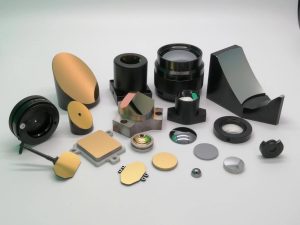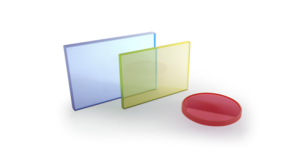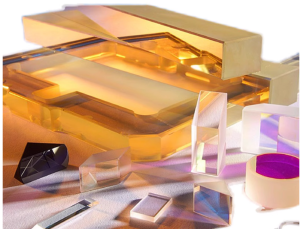Mirrors, which consist of flat surfaces, as shown in the figure, are important elements in optical systems for directing light through the appropriate path. Mirrors can be combined to form optical elements called retroreflectors or triangular prisms. These elements consist of three mirrored surfaces that are perpendicular to each other. This geometry allows for 180° reflection of light regardless of the angle of incidence, with little alignment required, unlike a single flat mirror. In addition to fixed mirrors, systems of rotating flat mirrors can also be used to achieve rapid redirection, such as in scanners or small systems with micro-mirrors for switching in telecommunications and displays. Curved mirrors (also called concave mirrors) can be used to collect, focus, and image light, as shown in the figure. Concave mirrors have an advantage over lenses (see Section III.A.3) in that they can be used over a wide range of wavelengths without the need for refocusing. This is because the reflection occurs at the surface of the optical element, rather than through the optical element as with a lens (see Section III.A.3), so there is no dispersion caused by the refractive index. A simple spherical reflector can be used to collect radiation from a source at a focal point (located at half the radius of curvature of the mirror) and reflect it as a collimated beam parallel to the optical axis. However, spherical mirrors are subject to spherical aberration (see Section III.A.3), so parabolic surfaces can be used instead to collimate light from a focal point or to focus light from a collimated beam (see figure). Circular surfaces can focus light from one focus to another (see figure).
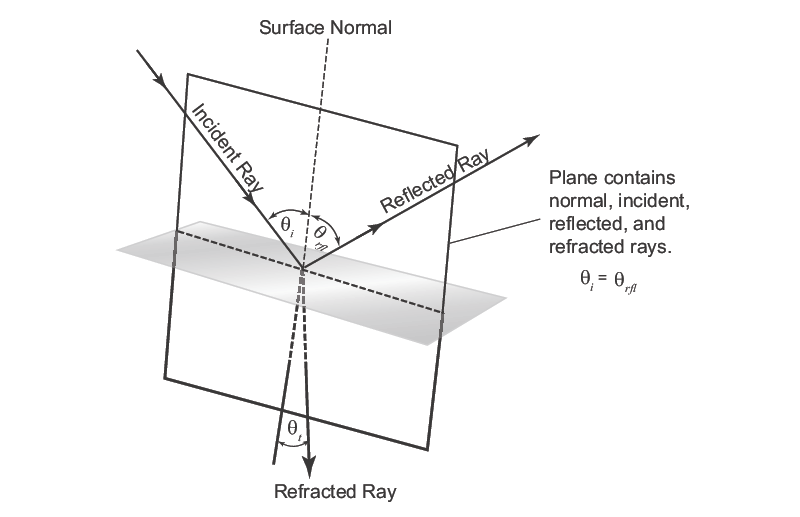
The fraction of incident light that is reflected or transmitted at an interface is described by the Fresnel equations [1, 138] and depends on the angle of incidence and the refractive index of the incident medium (n1) and the refractive index of the refracting medium (n2). The fraction of incident light that is reflected at an interface is called reflectance (R), while the fraction that is refracted in the two media is called transmittance (T). Assuming that both media are non-absorbing, the sum of R and T must be 1, so that information about one medium can be inferred from the other. In addition, different linear polarization components of the incident light (for details on polarization, see Section III.A.4) have different values of R and T. For perpendicular incident light, that is, θ i = 0, the Fresnel equations are greatly simplified. At perpendicular incidence, R in the equation no longer depends on angle and polarization (T is the complement of R) but only on the refractive index:


Mirrors, which consist of flat surfaces, as shown in the figure, are important elements in optical systems for directing light through the appropriate path. Mirrors can be combined to form optical elements called retroreflectors or triangular prisms. These elements consist of three mirrored surfaces that are perpendicular to each other. This geometry allows for 180° reflection of light regardless of the angle of incidence, with little alignment required, unlike a single flat mirror. In addition to fixed mirrors, systems of rotating flat mirrors can also be used to achieve rapid redirection, such as in scanners or small systems with micro-mirrors for switching in telecommunications and displays. Curved mirrors (also called concave mirrors) can be used to collect, focus, and image light, as shown in the figure. Concave mirrors have an advantage over lenses (see Section III.A.3) in that they can be used over a wide range of wavelengths without the need for refocusing. This is because the reflection occurs at the surface of the optical element, rather than through the optical element as with a lens (see Section III.A.3), so there is no dispersion caused by the refractive index. A simple spherical reflector can be used to collect radiation from a source at a focal point (located at half the radius of curvature of the mirror) and reflect it as a collimated beam parallel to the optical axis. However, spherical mirrors are subject to spherical aberration (see Section III.A.3), so parabolic surfaces can be used instead to collimate light from a focal point or to focus light from a collimated beam (see figure). Circular surfaces can focus light from one focus to another (see figure).
Mirror Properties
Selecting the right mirror for an application requires consideration of many factors, including reflectivity, laser damage, stability of the coating, thermal expansion of the substrate, wavefront distortion, light scattering, and cost. The properties of a mirror depend on the optical coating, substrate, and surface quality. The coating determines the reflectivity and stability of the mirror and is the most critical component of the mirror. Section III.A.2 discusses the deposition process for high-quality optical coatings. Mirror coatings are usually made of metallic or dielectric materials. The most common application of mirrors is when light is incident on the film from air (n 1 = 1), and the reflectivity given by the equation depends only on the refractive index of the material (n 2). Due to their electrical conductivity, the refractive index of metals is complex and has a large imaginary part over a wide wavelength range. This produces a high reflectivity that is insensitive to wavelength, giving metallic mirrors a shiny appearance. Metallic coatings are usually made of silver, gold, or aluminum, and the resulting mirrors can be used over a wide spectral range (see figure). Metallic coatings are relatively soft and therefore easily damaged, and special care must be taken when cleaning them. Dielectric mirrors are more durable, easier to clean, and have a higher damage threshold. However, due to their dispersion and the fact that the refraction is mainly real, dielectric mirrors have a narrow reflection spectrum and are typically used in the VIS and NIR spectral regions. Compared to metallic coatings, dielectric coatings offer greater design flexibility (see Section III.A.2). Compared to metallic mirrors, dielectric mirrors can provide higher reflectivity in certain spectral ranges and can provide customized spectral responses (see figure).
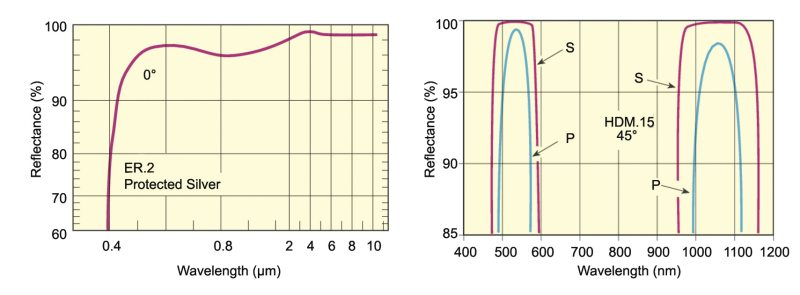
The substrates on which the coatings are deposited are usually dielectric materials [158], which control the thermal expansion and transmission properties of the mirror. Some materials (PYREX® borosilicate glass or fused silica) have lower coefficients of thermal expansion than others (N-BK7 optical glass), but the cost of the material and the ease of polishing must also be considered. If light is not required to pass through the substrate, the back side of the substrate is often ground to prevent unwanted transmission. For transmissive mirrors, it is important to have a substrate material with a uniform refractive index, such as fused silica.
Prior to depositing the optical coatings, the substrate surface must be ground and polished to the appropriate shape (flat or curved). Specific applications require specific mirror parameters, and the surface quality and flatness of the mirror determines its fidelity. Surface flatness is usually measured in wavelengths, for example, λ/10 over the entire usable area of the mirror. When wavefront preservation is critical, mirrors with a flatness of λ/10-λ/20 should be selected, while less demanding applications can choose mirrors with a flatness of λ/2-λ/5, with associated lower costs. Surface quality is often determined by the severity of random localized defects on the surface. These are often quantified in terms of a “scratch and pit” specification, e.g., 20-10, with lower values indicating a higher quality surface and therefore lower scatter. For high precision surfaces, such as those within a laser cavity, a scratch-dig specification of 10-5 may be required, which produces very little scattered light. Surface finish tolerances for irregularities, surface roughness, and cosmetic defects are verified using state-of-the-art metrology equipment. These same parameters and procedures can be used to evaluate the quality and flatness of other optical components, such as lenses or windows.
ABOUT BORISUN
Hanzhong Brisun Optics Co., Ltd. Is the high precision optical element manufacturer provides customized production of Various optical lenses, including spherical lens, cylindrical lens, optical window, mirror, prism, filter, metal base mirror and other high-precision optical elements. The base materials include various optical glass, fused quartz, calcium fluoride (CaF2), zinc selenide (ZnSe), germanium (GE), silicon (SI), sapphire, metal and other materials. And provide antireflective film, high reflection film, spectroscopic film, metal film and other optical coatings.
Welcome to OEM and Purchasing!
Recent Posts
Send Requests

